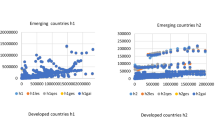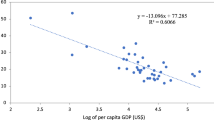Abstract
The functional form of consumer allocation models should be able to satisfy theoretical properties derived from the theory of consumer demand. The paper sketches four approaches that meet this condition. Of course, also empirical performance matters. Next to naive goodness-of-fit comparison, non-nested hypothesis testing can be employed. The latter technique is applied to a comparison of four versions of differential demand systems: the Rotterdam system, a version of the Almost Ideal Demand (AID) system, the CBS system and the NBR system. These systems are artificially nested in a more general model using scalar weights in contrast to Barten and McAleer (1991) who use matrix weights for this purpose. Annual data over the period 1921–1981 for The Netherlands for four major groups of consumer expenditure have been used for the empirical application. The CBS system dominates the others.
Similar content being viewed by others
References
Barten AP (1966) Het verbruik door gezinshuishoudingen in Nederland 1921–1939 en 1948–1961. Report 6604, Econometric Institute. Netherlands School of Economics, Rotterdam
Barten AP (1969) Maximum Likelihood Estimation of a Complete System of Demand Equations. European Economic Rev 1:7–73
Barten AP (1989) Towards a Levels Version of the Rotterdam and Related Demand Systems. In: Cornet B, Tulkens H (Eds) Contributions to Operations Research and Economics: The Twentieth Anniversary of CORE, Chapter 13. The MIT Press, Cambridge Mass, pp 441–465
Barten AP, Böhm V (1982) Consumer Theory. In: Arrow KJ, Intriligator MD (Eds) Handbook of Mathematical Economics, Vol II, Chapter 9. North-Holland, Amsterdam, pp 381–429
Barten AP, Geyskens E (1975) The Negativity Condition in Consumer Demand. European Economic Rev 6:227–260
Barten AP, McAleer M (1991) Comparing the Empirical Performance of Alternative Demand Systems, mimeo. Center for Economic Research, Tilburg University, The Netherlands
Byron RP (1970) The Restricted Aitken Estimation of Sets of Demand Relations. Econometrica 38:816–830
CBS (1982) Private Consumption Expenditure and Price Index Numbers for The Netherlands 1951–1977, Statistical Studies 33, Staatsuitgeverij, The Hague
Christensen LR, Jorgenson DW, Lau LJ (1975) Transcendental Logarithmic Utility Functions. American Economic Rev 5:367–382
Deaton AS (1974) The Analysis of Consumer Demand in the United Kingdom, 1900–1970. Econometrica 42:341–367
Deaton A (1975) Models and Projections of Demand in Post-War Britain. Chapman and Hall, London
Deaton A (1978) Specification and Testing in Applied Demand Analysis. The Economic Journal 88:524–536
Deaton A (1986) Demand Analysis. In: Griliches Z, Intriligator MD (Eds) Handbook of Econometrics, Vol III, Chapter 10. North-Holland, Amsterdam, pp 1767–1839
Deaton A, Muellbauer J (1980a) An Almost Ideal Demand System. American Economic Rev 70:312–326
Deaton A, Muellbauer J (1980b) Economics and Consumer Behavior. Cambridge University Press, Cambridge
Diewert WE (1971) An Application of the Shephard Duality Theorem: A Generalized Leontief Production Function. J Political Econ 79:481–507
Frisch R (1959) A Complete Scheme for Computing All Direct and Cross Demand Elasticities in a Model with Many Sectors. Econometrica 27:177–196
Gossen HH (1854) Entwicklung der Gesetze des menschlichen Verkehrs und der daraus fliessenden Regeln für menschliches Handeln, Neue Ausgabe. Prager, Berlin, 1889
Johansen L (1981) Suggestions Towards Freeing Systems of Demand Functions from a Strait-Jacket. In: Deaton A (Ed) Essays in the Theory and Measurement of Consumer Behaviour in Honour of Sir Richard Stone, Chapter 2. Cambridge University Press, Cambridge, pp 31–54
Keller WJ, van Driel J (1985) Differential Consumer Demand Systems. European Economic Rev 27:375–390
Kiefer NM, MacKinnon JG (1976) Small Sample Properties of Demand System Estimates. In: Goldfeld SM, Quandt RE (Eds) Studies in Nonlinear Estimation. Ballinger, Cambridge, pp 181–210
Klevmarken NA (1979) A Comparative Study of Complete Systems of Demand Functions. Journal of Econometrics 10:165–192
McAleer M (1983) Exact Tests of a Model Against Nonnested Alternatives. Biometrika 70:285–288
Neves P (1987) Analysis of Consumer Demand in Portugal, 1958–1981. Mémoire de maîtrise en sciences économiques. Université Catholique de Louvain. Louvain-la-Neuve
Parks RW (1969) Systems of Demand Equations: An Empirical Comparison of Alternative Functional Forms. Econometrica 37:629–650
Parks RW (1971) Maximum Likelihood Estimation of the Linear Expenditure System. Journal of American Statist Assoc 66:900–903
Pesaran MH (1982) On the Comprehensive Method of Testing Non-Nested Regression Model. J Econometrics 18:263–274
Roy R (1942) De l'utilité. Contribution à la théorie des choix. Hermann, Paris
Shephard R (1953) Cost and Production Functions. Princeton University Press, Princeton
Solari L (1971) Théorie des choix et fonctions de consommation semi-agregées. Droz, Genève
Stone R (1954) Linear Expenditure Systems and Demand Analysis: An Application to the Pattern of British Demand. The Economic Journal 64:511–527
Theil H (1965) The Information Approach to Demand Analysis. Econometrica 33:67–87
Theil H (1967) Economics and Information Theory. North-Holland, Amsterdam
Van Driel J, Hundepool AJ (1984) Private Consumption Expenditure and Price Index Numbers for The Netherlands, 1977–1981. mimeo, Central Bureau of Statistics
Author information
Authors and Affiliations
Additional information
The author is indebted to Leon Bettendorf for his assistance in setting up the data base and wishes to thank the participants of the XVIIth International Conference on Problems of Building and Estimation of Large Econometric Models, Jachranka, Poland, December 1990, and several anonymous referees for their constructive criticism on earlier drafts of the paper.
Rights and permissions
About this article
Cite this article
Barten, A.P. Consumer allocation models: Choice of functional form. Empirical Economics 18, 129–158 (1993). https://doi.org/10.1007/BF01238883
Received:
Revised:
Issue Date:
DOI: https://doi.org/10.1007/BF01238883




